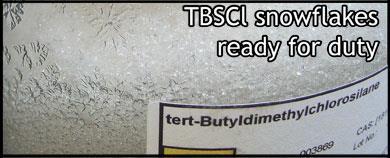Dylan Stiles revels in chemistry's massive protection racket
Pick up a copy of your favourite organic chemistry journal and glance at the scheme for a synthetic sequence. Attached to the sticks and wedges you’re likely to see a veritable alphabet soup: TBS, TIPS, Ac, Bn, Bz, MOM, BOM, Fmoc, Boc, Cbz, SEM, MTM and Ts, to name a few. A true organic chemist will be able to rattle off the full names for all of the above, but in case you can’t I’ll tell you that they are all protecting groups.
There’s a recurring problem in synthesis where functional groups in a molecule are prone to unwanted side reactions. Usually the culprits are alcohols, amines, and carboxylic acids. A good synthetic route mitigates the issue by not introducing the troublesome functionality until necessary, but sometimes the problem is unavoidable. Protecting groups that mask reactive parts of the molecule are the solution.

When appointing a protecting group, you need to consider factors like its stability towards the barrage of reagents it will fend off. Choosing the right one is not always easy, but in the world of alcohols, silicon reigns supreme. Elias James Corey got the ball rolling many moons ago in a landmark article that might as well have described a technique for bread slicing. Here, Corey offers his gift to the world: the tert -butyldimethylsilyl (TBS) group. All things being equal, TBS is a great general purpose protecting group and a good place to start. While it’s a little on the heavy side, it means you can double the mass of your material when putting it on a small molecule (very satisfying after a string of bad luck in the lab). Of course, all that extra mass is an illusion that you don’t realise until later. You’re at a late stage in your synthesis, down to a few precious milligrams, and you almost forgot that half of that is just protecting groups along for the ride. Global desilylation cuts the mass in half, leaving you crestfallen with a mere stain of product on the bottom of the flask. Such is the emotional roller coaster ride of chemistry.
Nitrogen land is ruled by tert -butoxycarbonyl, the notorious BOC. A cursory investigation into the ancestry of this protecting group revealed that it was first used to protect amino acids in 1957.2 Most of the time, BOC is put on an amine using BOC-anhydride, (BOC)2 O. It has the amusing property of melting right around room temperature, so chemists are split on whether it’s better to dispense it as a liquid or a solid. I’m a Solid Person; I weigh it out in a mad dash before it turns to a puddle on the tip of the spatula. The Liquid People would rather put the bottle on top of the oven for the duration of a coffee break, and then syringe it out when they get back. But I’ve had traumatic experiences doing this with low-melters, because they can solidify in the syringe if you’re not careful.
Getting these wonderful protecting groups off the molecule is another matter entirely. Fluoride salts are normally used to liberate alcohols from silyl protecting groups, but while tetrabutylammonium fluoride (TBAF) is the most common agent, commercial TBAF solutions are loaded with hydroxide and can do a number on base-sensitive groups. Acidic reagents like HF.pyridine can get around these issues, but I have to say that I’m a big fan of straight up hydrofluoric acid. True, HF can dissolve your bones, but if you treat it with love and respect you will be rewarded with high yields and chemoselectivity.
Taking off a BOC group is usually a no-brainer. Put the substrate into a round bottom flask and pour in some neat trifluoroacetic acid. Right away carbon dioxide and isobutylene start to bubble out of solution, the BOC group literally falling apart. Having served its duty valiantly it leaves behind an amine, unprotected, and a molecule significantly less heavy than it once was. It’s a bittersweet moment watching a protecting group crumble before your eyes.












No comments yet